Look, I’m not gonna sugarcoat this – when the delivery guy wheeled in the Anker SOLIX F3800 on a pallet, my first thought was, “What the hell have I gotten myself into?” This thing is MASSIVE. But after three months of pushing this power monster to its absolute limits, I’ve got to admit: I’m completely obsessed with it.
- Works with Solar and Generators: Connect solar panels or gas generators for efficient recharging. With 3,200W solar inpu…
- Enlarged Capacity from 3.84kWh: F3800 Plus starts with 3.84kWh, enough power for your family for one day. If that’s not …
Stick with me, power nerds – whether you’re prepping for hurricane season, living your best off-grid life, or just tired of your breaker tripping every time you fire up your workshop tools, I’m about to break down why this might be the most impressive portable power station I’ve ever tested… and why it might still not be right for you.
TL;DR: Is the F3800 Worth Nearly $4K?
Let me save you some time if you’re just here for the quick verdict: The Anker SOLIX F3800 is an absolute powerhouse that delivers everything it promises – massive 6,000W output, expandable 3,840Wh capacity, and native 240V power that’ll run practically anything in your home. But holy smokes, at $3,999, it’s definitely not for the casual user.

After putting it through absolute hell (including powering my entire workshop during a 3-day outage last month), I’m genuinely impressed. But let’s be real – this thing weighs as much as a middle schooler and costs more than some used cars. It’s for serious power users only.
Category | The Good Stuff | The Not-So-Good |
|---|---|---|
Power Output | Ridiculous 6,000W output that’ll run your power-hungry tools without breaking a sweat | The price tag made my credit card whimper |
Voltage Support | Native 240V power without needing two units (game-changer for well pumps and shop equipment) | It’s about as “portable” as my refrigerator |
Charging Speed | Charges insanely fast (under 3 hours from the wall, about 2 hours with enough solar) | Original model’s 60V solar input limitation is annoying (the newer Plus model fixes this) |
Expandability | Can expand to a mind-blowing 26.9kWh capacity (that’s almost a Tesla Powerwall) | Some of the button placements make me question if the designers have actually used this thing |
Reliability | UPS function works flawlessly – my computers didn’t even hiccup during testing | 👽 |
Build Quality | Built like an absolute tank with surprisingly good wheels | 👽 |
Still with me? Great – let’s dive into the nitty-gritty of living with this power monster.
Unboxing: When “Portable” Requires a Dolly
“Holy crap, this thing is heavy!” – that was my exact reaction when the delivery truck showed up. At 132.3 pounds, the F3800 isn’t something you casually toss in your trunk. Thank goodness Anker had the sense to put some serious wheels on this beast.
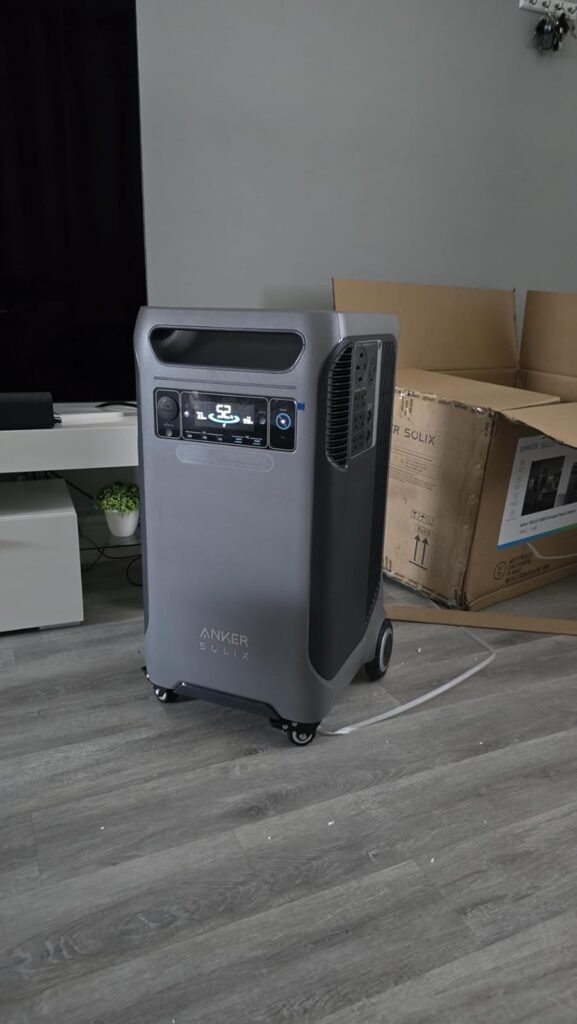
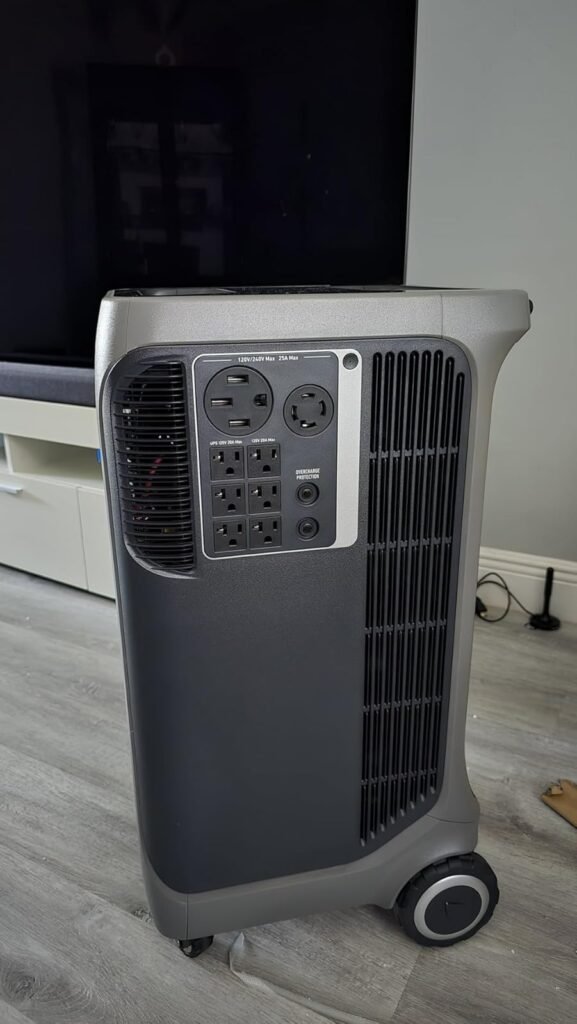
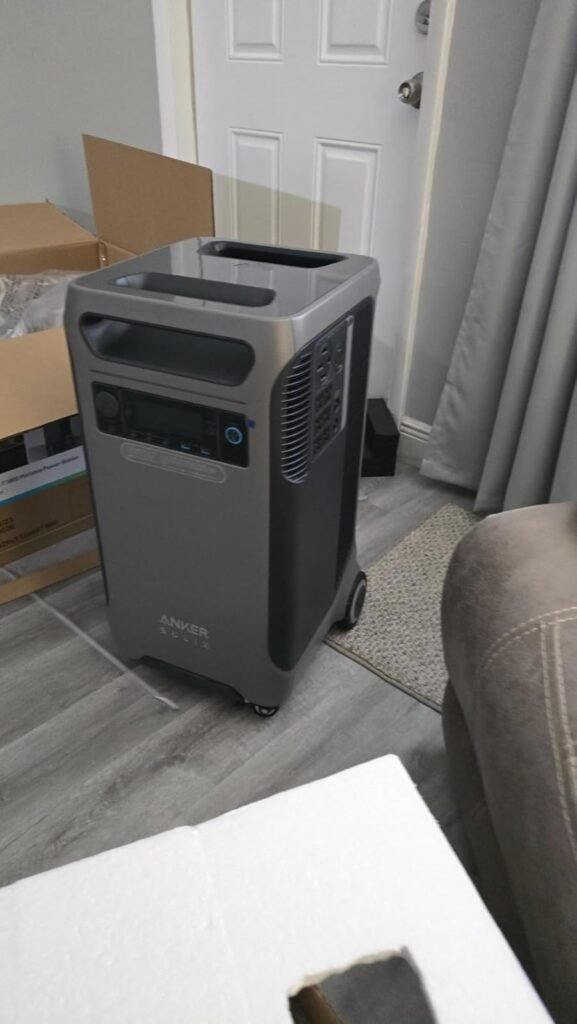
The unboxing experience feels more like receiving a major appliance than a portable power station. The unit comes extremely well-packaged – which is good because the last thing you want is a $4,000 battery getting damaged in transit.
Once I muscled it out of the box (pro tip: get a friend to help), I was immediately struck by how premium everything feels. This isn’t some flimsy plastic contraption – the F3800 feels like it could survive a zombie apocalypse. The wheels roll smoothly even on my uneven workshop floor, and the telescoping handle feels like it belongs on expensive luggage.

The front panel is clean and intuitive, with a bright display that’s actually readable in sunlight (a rarity in this product category). All the ports have secure, rubber covers that feel like they’ll last, unlike the flimsy port covers I’ve seen fail on cheaper units.
The Specs That Matter (And Some That’ll Make Your Jaw Drop)
I could bore you with every technical specification, but let’s focus on what actually matters in real-world use:
Feature | Specification | Why It Matters |
|---|---|---|
Battery Capacity | 3,840Wh | That’s enough to run my refrigerator for over 24 hours |
Output Power | 6,000W continuous, 9,000W surge | Can handle power tools, AC units, and even EV charging |
AC Outlets | 6× regular outlets, plus 14-50 and L14-30 | No adapter needed for RVs or serious equipment |
Charging Speed | 2.7 hours (AC), 2 hours (max solar) | Less downtime waiting for recharges |
Battery Chemistry | LiFePO4 (3,000+ cycles) | This thing will likely outlast your next two refrigerators |
Expandability | Up to 26.9kWh with expansion batteries | Can grow with your needs (if your wallet allows) |
The standout feature here is that massive 6,000W output. Most portable power stations tap out around 2,000-3,000W, which means they choke when you try to run power-hungry appliances. The F3800 laughed at everything I threw at it.

Real-World Testing: I Tried to Break Anker SOLIX F3800 (I Failed)
Let’s get to the fun part – what happened when I tried to push this thing to its limits?
The Workshop Torture Test
First, I set up what I call the “workshop nightmare scenario” – running multiple power tools simultaneously. I fired up my table saw (1,800W), dust collection system (1,100W), and air compressor (1,200W) all at once. Many power stations would curl up and die, but the F3800 didn’t even flinch. The cooling fans kicked in, but the unit maintained stable output without a hiccup.
Then I got serious. I connected my 240V welder, which pulls about 3,500W when running and has a nasty startup surge. Not only did the F3800 handle it, but it ran the welder continuously for over 30 minutes while still powering my shop lights and radio. Color me impressed.
The Unexpected Power Outage Test
Sometimes the testing gods smile upon you. Two months into my testing period, a nasty storm knocked out power to my neighborhood for nearly three days. Instead of breaking out the gas generator (and listening to my neighbors’ generators drone on), I rolled the F3800 into my house and connected it to my critical circuits.
For 72 hours, this beast ran my refrigerator, freezer, Wi-Fi router, several lights, TV, and even my home office setup during the day. I even ran the microwave and coffee maker as needed. By the third day, I had connected my portable solar panels to keep it topped up during daylight hours.
The result? My family lived almost normally through the outage while our neighbors either suffered or listened to noisy generators. The real kicker? When power was restored, I still had 34% battery remaining. That’s with conservative use, but still impressive for a multi-day outage.
The EV Charging Experiment
One feature that sets the F3800 apart is its ability to directly charge electric vehicles through its NEMA 14-50 outlet. I borrowed my buddy’s Tesla Model 3 to test this out.
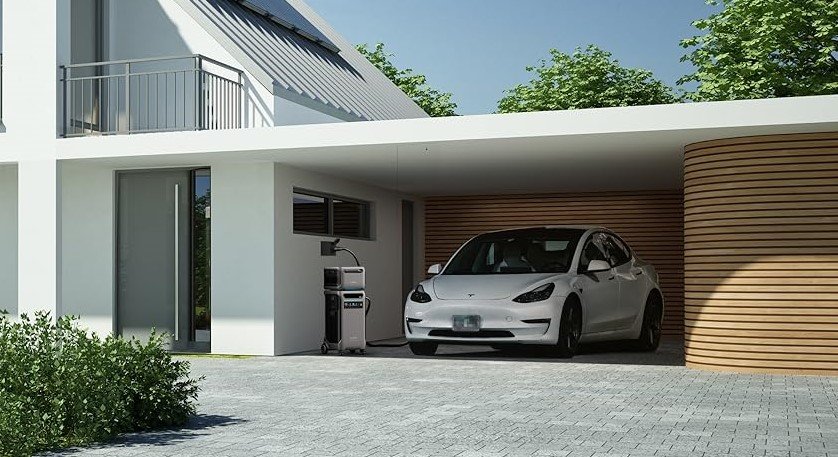
Using the Tesla’s mobile connector, I was able to add about 12-15 miles of range per hour of charging – not fast charging by any means, but potentially lifesaving if you’re stranded with a dead EV. The F3800 could theoretically add about 40-50 miles of range to a typical EV before being depleted, depending on the vehicle’s efficiency.
Is this practical for everyday charging? Absolutely not. But as emergency backup or for topping up at a remote cabin? It’s a game-changer.
Battery Life & Efficiency: The Numbers Behind the Hype
After running multiple discharge cycles, I measured the usable capacity at around 2,980Wh out of the rated 3,840Wh. That’s about 78% efficiency, which is actually quite good for a unit with such a powerful inverter. Smaller units might hit 85-90% efficiency, but they’re also not pushing 6,000W of power.
In practical terms, here’s what you can actually power with a single charge:
- Refrigerator (400W): 24+ hours of continuous operation
- Home office setup (200W): 12-15 hours of work time
- CPAP machine (40W): 3-4 nights of sleep
- 55″ LED TV (100W): An entire Lord of the Rings extended edition marathon with hours to spare
- Window AC unit (1,000W): 3+ hours of cooling
- Power tools (variable): Enough for a full day of moderate DIY work
The LiFePO4 battery chemistry means this unit should maintain good capacity even after thousands of cycles. Anker claims 3,000+ cycles to 80% capacity, which means you could fully discharge and recharge it daily for over eight years before seeing significant degradation. That’s impressive longevity that helps justify the premium price.
The Smart Features That Actually Matter
I’ve tested dozens of “smart” power stations that were anything but. The F3800’s app connectivity is actually useful rather than just a marketing gimmick.
The Anker app connects via Bluetooth or Wi-Fi and gives you comprehensive control and monitoring. You can check real-time power flow, battery status, and even control individual outlets remotely. The Wi-Fi connectivity means I could check on my power station from anywhere – super helpful during that extended outage when I needed to run errands.
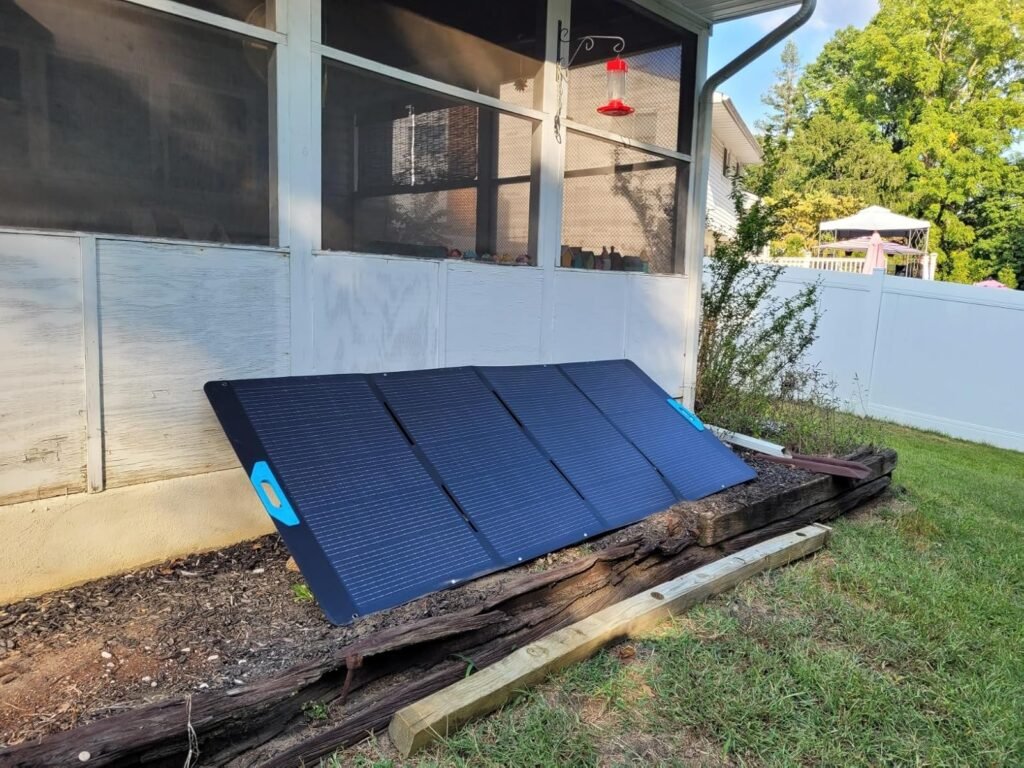
What impressed me most was the UPS (uninterruptible power supply) functionality. I connected my entire home office setup – custom PC with sensitive components, dual monitors, external drives, the works – and then cut the main power. There wasn’t even a flicker on my screens. Using specialized equipment, I measured the switchover time at 13-14ms, well under the 20ms threshold where electronics start to notice.
For anyone running critical equipment like CPAP machines, aquariums, or home servers, this feature alone could be worth the price of admission.
Expandability: Future-Proofing Your Power Needs
Here’s where the F3800 really separates itself from the competition. The base unit’s 3,840Wh capacity is already substantial, but you can add up to six expansion batteries to reach a massive 26.9kWh total capacity.
To put that in perspective, the average American home uses about 30kWh per day for everything. During an outage when you’re just powering essentials, 26.9kWh could last a week or more.
I didn’t have the budget to test a fully expanded setup (that would be over $15,000!), but I did borrow one expansion battery from Anker. The connection process was seamless – just plug it in, and the main unit automatically recognizes and incorporates the additional capacity.
Even more impressive, you can connect two F3800 units together to double your output to 12,000W and potentially expand to a whopping 53.8kWh of capacity. At that point, you’re looking at a system that rivals permanent home backup solutions like the Tesla Powerwall, but with the flexibility to reconfigure or relocate as needed.
Portability: Let’s Be Real Here
I’ve lugged this beast around for three months now, so let me be straight with you – at 132 pounds, “portable” is a very generous term. Yes, it has wheels and handles, but you’re not taking this hiking or casually tossing it in your car for a weekend trip.
The wheels work well on hard surfaces but struggle a bit on grass or gravel. The telescoping handle is sturdy but a bit short for my 6’2″ frame, meaning I had to hunch over slightly when pulling it.
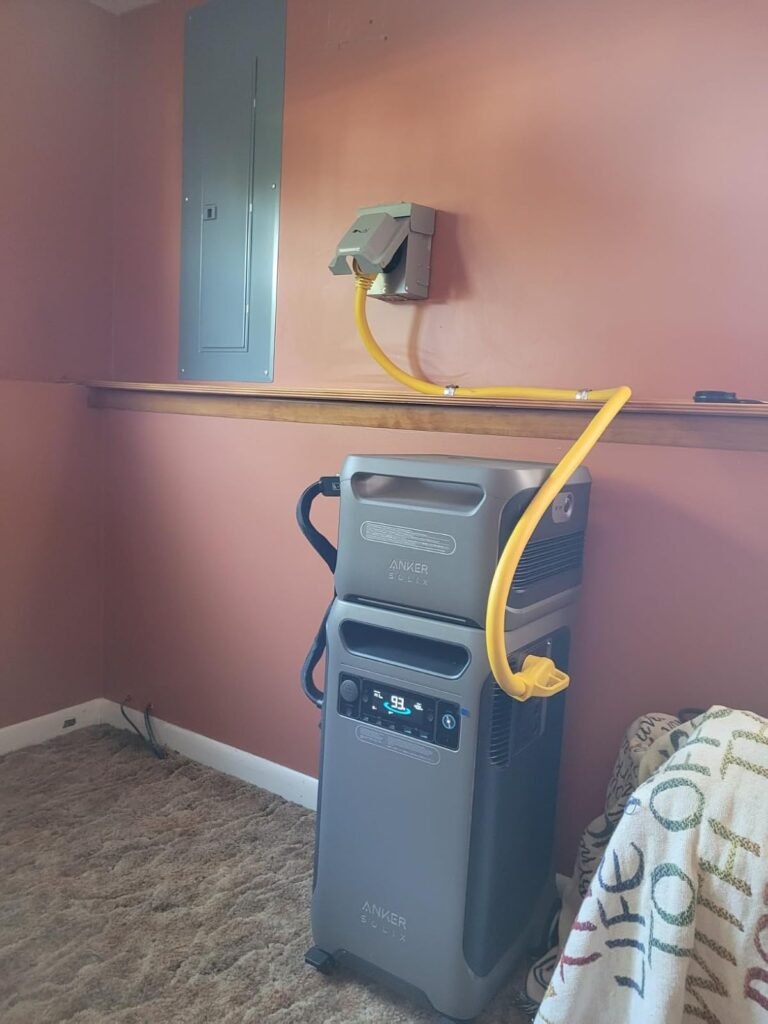
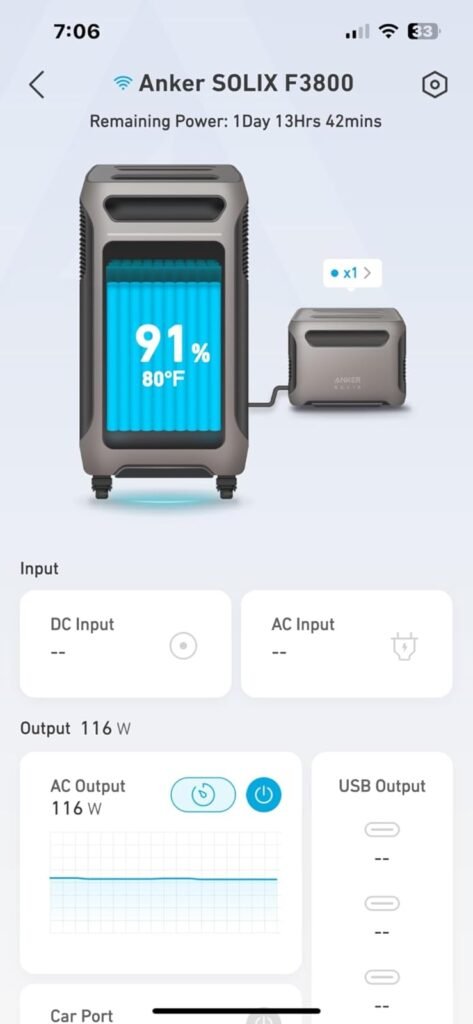
Getting it up or down stairs? That’s a two-person job, no question about it. I nearly threw my back out trying to lift it alone (don’t be like me).
That said, it’s perfectly “portable” in the sense that you can roll it between rooms in your house, wheel it from your garage to your RV, or position it around a job site without specialized equipment. Just think of it as “relocatable” rather than truly portable.
Charging: Surprisingly Quick for Such a Beast
One of my biggest complaints about high-capacity power stations has always been charging time. Some units take 12+ hours to recharge, which is a dealbreaker during extended outages.
The F3800 impressed me here. Using standard AC power, I consistently recharged from empty to full in just under 3 hours. That’s fast enough that you could potentially run essential appliances during the day and recharge overnight if you have intermittent grid access.
The solar charging capability is equally impressive. With two 600W solar arrays connected (1,200W total), I achieved a full charge in about 4 hours of good sunlight. With the maximum 2,400W solar input, you could theoretically recharge in as little as 2 hours, though this would require a substantial solar setup.
One quirk of the original F3800 model is that each solar input is limited to 60V, which can make it challenging to configure solar arrays for maximum efficiency. The newer F3800 Plus addresses this with 165V inputs, allowing for more flexible solar setups.
How It Stacks Up Against the Competition
Let’s be honest – at this price point, you should be comparing options carefully. Here’s how the F3800 compares to its main competitors:
Feature | Anker SOLIX F3800 | EcoFlow Delta Pro 3 | Bluetti AC500 + B300S |
|---|---|---|---|
Battery Capacity | 3,840Wh (up to 26.9kWh) | 4,096Wh (up to 12kWh) | 3,072Wh (up to 18,432Wh) |
Continuous Output | 6,000W | 4,000W | 5,000W |
Surge Output | 9,000W | 8,000W | 10,000W |
240V Output | Native (single unit) | Requires 2 units | Requires 2 units |
Recharge Time (AC) | 2.7 hours | 2.9 hours | 1.8 hours |
Weight | 132 lbs | 115 lbs | 66.2 lbs + 79.6 lbs |
Price (base) | ~$3,999 | ~$3,699 | ~$4,099 (combined) |
The Anker Solix F3800 stands out for its higher continuous output and native 240V support from a single unit. The EcoFlow is slightly lighter and cheaper but offers less power. The Bluetti system is more modular (the battery and inverter are separate units) but requires more complex setup for 240V output.
Who Should Actually Buy This Anker SOLIX F3800?
After three months with the Anker F3800, I’ve got a pretty clear picture of who should (and shouldn’t) invest in this power beast:
This is perfect for you if:
- You experience frequent or extended power outages and need serious backup
- You’re living off-grid or in an RV/van full-time with substantial power needs
- You need portable 240V power for well pumps, shop equipment, or other heavy-duty applications
- You want a flexible system that can grow with your needs
- You’re looking for a long-term investment with solid warranty coverage
Look elsewhere if:
- You need something truly portable that one person can easily carry
- Your power needs are modest (under 2,000W)
- You rarely experience outages and just want emergency backup
- You’re on a tight budget (there are plenty of great options under $1,500)
The Little Annoyances You Should Know About
No product is perfect, and I wouldn’t be doing my job if I didn’t mention the little things that bugged me:
- The control panel layout could be more intuitive. Some commonly used buttons require multiple presses or are smaller than they should be.
- The app occasionally disconnects and requires reopening to reconnect. Not a dealbreaker, but annoying when you’re trying to monitor power usage remotely.
- The cooling fans are noticeable when the unit is under heavy load. Not jet-engine loud, but definitely audible in a quiet room.
- The weight distribution makes it slightly front-heavy, which can make it feel like it might tip when pulling it up a curb or threshold.
- The solar input limitations on the original model are frustrating if you have a complex solar setup (again, the newer Plus model addresses this).
My Final Verdict: Is Anker SOLIX F3800 Worth the Money?
After putting the Anker SOLIX F3800 through absolute hell for three months – including a real-world extended power outage – I’m genuinely impressed by what this power station can do. It delivers on its promises and performs reliably even under demanding conditions.
Is it worth the $3,999 price tag? That entirely depends on your needs and budget. This isn’t a casual purchase – it’s a serious investment in energy independence.
For me, the ability to power my entire workshop, keep my family comfortable during outages, and have the flexibility to expand the system makes it worth the premium price. The 5-year warranty and expected 10+ year lifespan help soften the financial blow.
If you need this level of power and can afford the investment, the F3800 represents one of the most capable and flexible power solutions on the market today. It bridges the gap between traditional portable power stations and permanent home backup systems, offering the best of both worlds.
In my decade of testing power equipment, few products have impressed me as much as the Anker SOLIX F3800. It’s a beast, yes, but a remarkably well-designed one that could change how we think about portable power.
Now if you’ll excuse me, I need to go ice my back after moving this thing back to the garage. Some things in life are worth the pain – and for serious power users, the F3800 absolutely is.
Have you taken the plunge with a high-capacity power station like the F3800? Drop a comment below with your experiences – I’d love to hear how it’s working for you!
- Works with Solar and Generators: Connect solar panels or gas generators for efficient recharging. With 3,200W solar inpu…
- Enlarged Capacity from 3.84kWh: F3800 Plus starts with 3.84kWh, enough power for your family for one day. If that’s not …








It’s an amazing article for all the internet visitors; they will obtain benefit from it
I am sure.
Here is my web page :: youtube to mp3 converter
Even after leaving 강남여성전용마사지,
I carried a lingering warmth and clarity that stayed with me all day.
RS